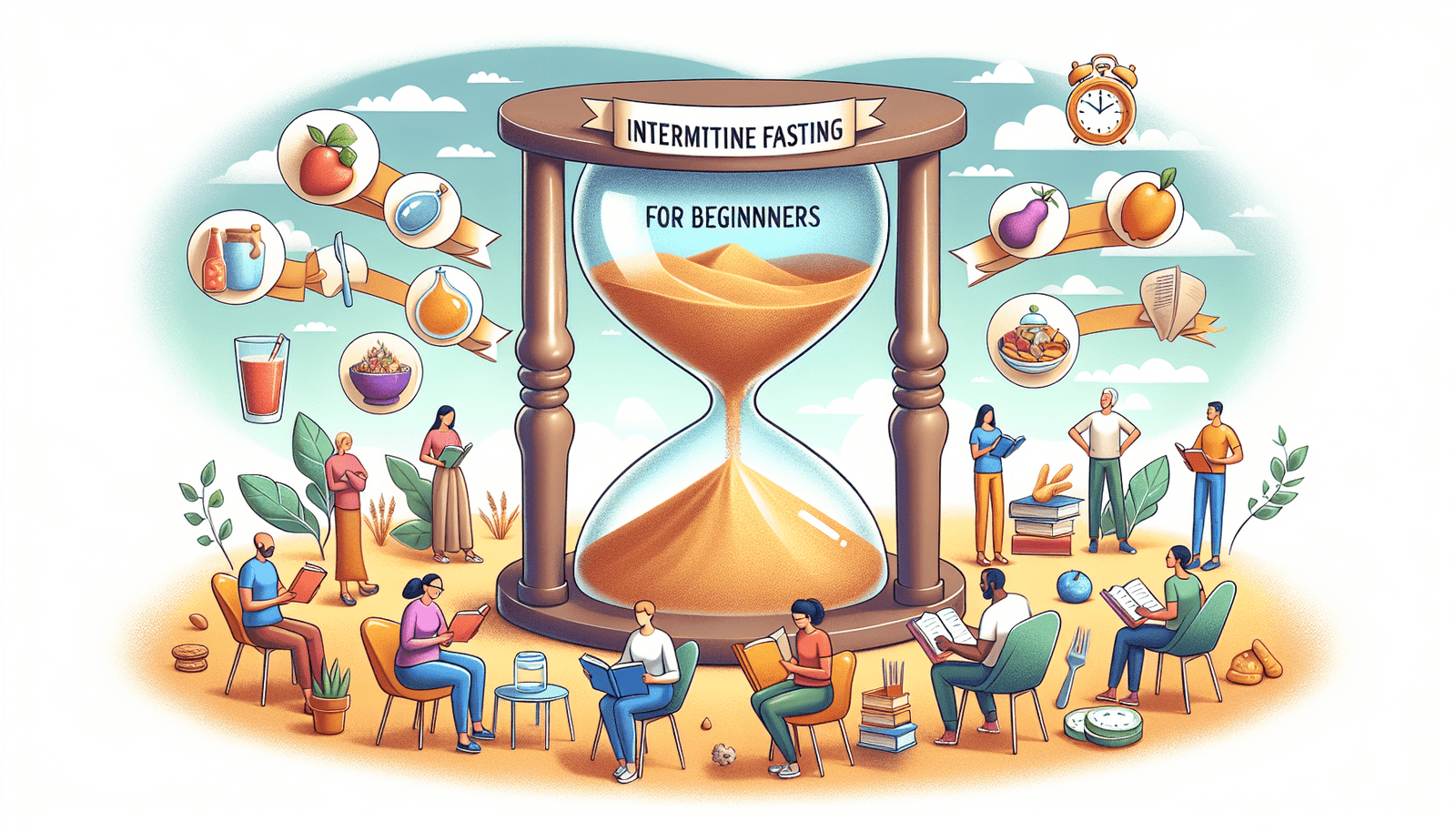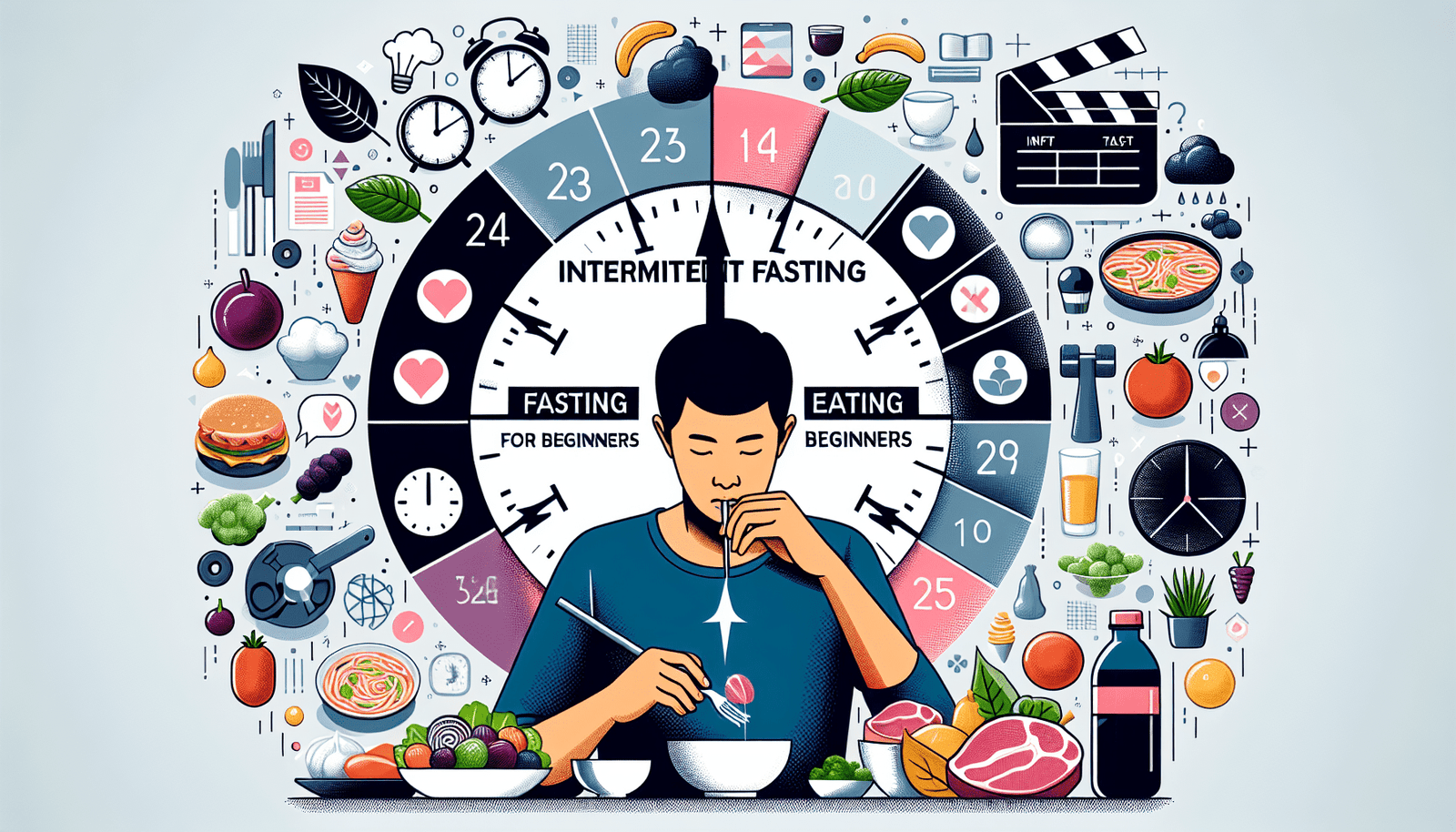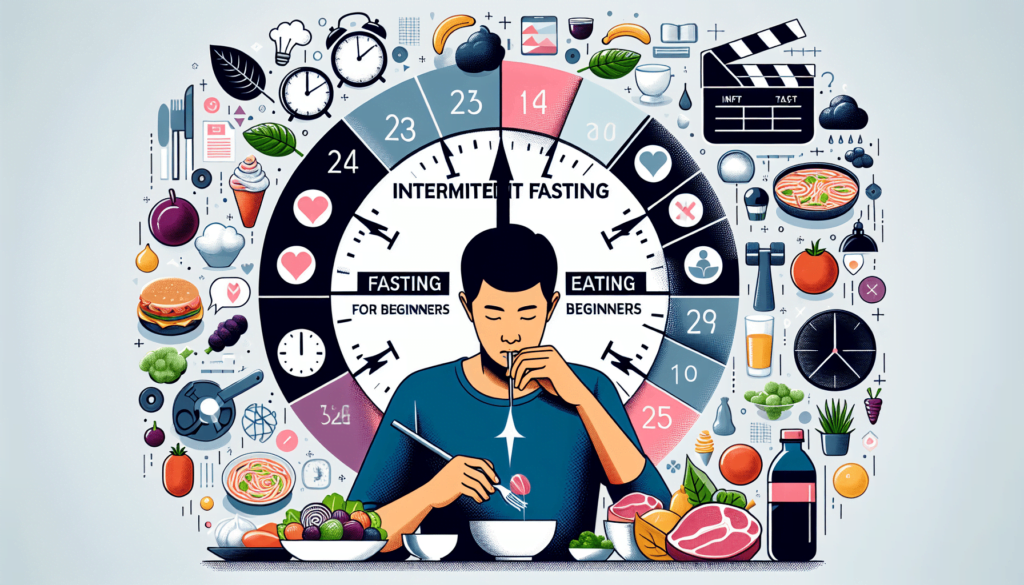So you’ve heard about the benefits of intermittent fasting and you’re ready to give it a try. But with so many different techniques out there, how do you know which one is right for you? In this beginner’s guide, we’ll break down the various intermittent fasting methods, from 16/8 to alternate day fasting, and help you figure out the best approach to suit your lifestyle and goals. So whether you’re looking to lose weight, improve your mental clarity, or simply achieve better overall health, read on to discover the perfect intermittent fasting technique for you.

Understanding Intermittent Fasting
What is intermittent fasting?
Intermittent fasting is a dietary approach that involves cycling between periods of eating and fasting. Unlike traditional dieting, which focuses on what you eat, intermittent fasting focuses on when you eat. It is not a specific diet, but rather a pattern of eating that has gained popularity in recent years.
How does intermittent fasting work?
Intermittent fasting works by allowing your body to enter a state of fasting, which can have numerous health benefits. During the fasting period, your body undergoes physiological changes that can support weight loss, improve insulin sensitivity, promote cellular repair, and even enhance brain function. By restricting your eating window, intermittent fasting helps control calorie intake and promotes a state of caloric deficit, which is crucial for weight loss.
Benefits of intermittent fasting
Intermittent fasting has been associated with a range of health benefits. Some of these benefits include weight loss, improved metabolic health, reduced inflammation, increased energy levels, enhanced cognitive function, and improved longevity. Additionally, intermittent fasting can help promote discipline and mindful eating habits.
Is intermittent fasting suitable for everyone?
While intermittent fasting can be a safe and effective way to improve health and lose weight for many people, it may not be suitable for everyone. It’s important to consider individual circumstances, such as existing medical conditions, lifestyle factors, and personal preferences, before starting an intermittent fasting regimen. Consulting with a healthcare professional is recommended, especially for individuals with specific dietary needs or medical concerns.
Different Intermittent Fasting Techniques
16/8 Method
The 16/8 method is one of the most popular intermittent fasting techniques. It involves fasting for 16 hours each day and restricting your eating window to 8 hours. This method can be easily incorporated into a daily routine and is relatively flexible, allowing individuals to choose their fasting and eating times based on personal preference.
5:2 Diet
The 5:2 diet involves eating normally for five days of the week and restricting calorie intake to 500-600 calories on the remaining two days. On fasting days, individuals can choose whether to skip meals altogether or consume small, low-calorie meals throughout the day. This technique provides flexibility in terms of choosing the fasting days, but it may require more planning and discipline.
Alternate-Day Fasting
Alternate-day fasting involves alternating between fasting days and regular eating days. On fasting days, calorie intake is significantly reduced or eliminated altogether, while on non-fasting days, individuals can eat normally. This method may be more challenging for some individuals due to the longer fasting periods.
Eat-Stop-Eat
The Eat-Stop-Eat method involves fasting for a full 24 hours once or twice a week. During the fasting period, only calorie-free beverages such as water, black coffee, or herbal tea are allowed. This technique may be more suitable for individuals who are comfortable with longer fasting periods and can adhere to the full 24-hour fast.
Warrior Diet
The Warrior Diet follows a 20-hour fasting period followed by a 4-hour eating window each day. During the fasting period, small amounts of fruits, vegetables, and lean proteins can be consumed. The 4-hour eating window typically consists of one large meal. This method may appeal to individuals who prefer a more restrictive eating pattern.
OMAD (One Meal a Day)
OMAD, or One Meal a Day, involves fasting for 23 hours and consuming all daily calories within a one-hour eating window. This method can be challenging for some individuals due to the long fasting period and limited eating window. It is important to ensure that all necessary nutrients are consumed within this one meal.
Spontaneous Meal Skipping
Spontaneous meal skipping is a more flexible form of intermittent fasting that involves skipping meals whenever it is convenient or desired. It does not adhere to a strict fasting schedule but allows individuals to fast intermittently based on their preferences and lifestyle.
Time-Restricted Eating
Time-restricted eating involves restricting your eating window to a specific time period each day. This can be as short as 10 hours or as long as 12 hours. For example, if you choose a 10-hour eating window, you would fast for 14 hours each day. This technique is relatively easy to implement and allows for flexibility in choosing the fasting and eating hours.
Evaluating Your Lifestyle and Goals
Assessing your daily routine
When choosing an intermittent fasting technique, it is important to assess your daily routine to determine which method aligns best with your lifestyle. Consider your work schedule, family commitments, and social activities to choose a fasting pattern that is manageable and sustainable in the long term.
Considering your dietary preferences
Take into account your dietary preferences when selecting an intermittent fasting technique. Some methods, such as the 5:2 diet or Warrior Diet, may allow for more flexibility in food choices on non-fasting days, while others, like OMAD, may require more careful meal planning to ensure nutrient adequacy.
Determining your weight loss or health goals
Identify your specific weight loss or health goals to help guide your choice of an intermittent fasting technique. If weight loss is your primary objective, methods that promote a larger caloric deficit, such as alternate-day fasting or OMAD, may be more suitable. If your focus is on overall health improvement, methods with shorter fasting periods, like the 16/8 method or time-restricted eating, may be more appropriate.
Identifying any existing medical conditions
It is crucial to consider any existing medical conditions before starting intermittent fasting. Some conditions, such as diabetes or eating disorders, may require modifications to fasting protocols or the need for close medical supervision. Consulting with a healthcare professional is essential to ensure that your chosen intermittent fasting technique is safe and appropriate for your specific circumstances.

Factors to Consider
Feasibility and sustainability
One of the key factors to consider when choosing an intermittent fasting technique is its feasibility and sustainability in the long term. Select a method that fits well with your lifestyle, preferences, and schedule, as this will increase the likelihood of success and adherence.
Compatibility with your schedule
Consider how your chosen intermittent fasting technique fits into your daily schedule. Certain methods, such as the 5:2 diet or alternate-day fasting, may require more planning and consideration compared to methods like time-restricted eating or the 16/8 method. Choose a technique that aligns with your schedule and allows you to maintain a balanced lifestyle.
Social and psychological implications
Take into account the social and psychological implications of your chosen intermittent fasting technique. Some methods, such as the 16/8 method or time-restricted eating, can be easily integrated into social settings and may have minimal impact on your social life. However, more restrictive methods like OMAD or the Warrior Diet may require more adjustment and may affect social interactions.
Potential side effects
Consider any potential side effects associated with your chosen intermittent fasting technique. While intermittent fasting is generally safe for most individuals, it is important to be aware of potential issues such as hunger, irritability, or decreased energy levels. These side effects are typically transient and resolve as the body adapts to the fasting routine, but understanding and managing them can help ensure a positive experience.
Ability to adhere to the fasting period
Finally, consider your ability to adhere to the fasting period required by your chosen technique. Some individuals may find it easier to fast in the morning hours, while others may struggle with late-night eating. Choose a method that aligns with your natural eating rhythms and allows for sustainable adherence.
Benefits and Drawbacks of Each Technique
16/8 Method: Benefits and Drawbacks
The 16/8 method offers simplicity and flexibility, making it an excellent choice for beginners. It can be easily incorporated into a daily routine and may help improve insulin sensitivity, promote weight loss, and boost metabolic health. However, some individuals may find it challenging to abstain from food for 16 hours, especially in the morning hours.
5:2 Diet: Benefits and Drawbacks
The 5:2 diet offers flexibility with its two fasting days each week, allowing individuals to choose the days that work best for them. It can be effective for weight loss and may help improve insulin sensitivity. However, the restricted calorie intake on fasting days may be challenging, and some individuals may experience increased hunger and decreased energy levels.
Alternate-Day Fasting: Benefits and Drawbacks
Alternate-day fasting promotes a larger caloric deficit and may result in significant weight loss. It can also improve insulin sensitivity and promote fat burning. However, the longer fasting periods can be challenging for some individuals, and the potential for increased hunger and irritability may be a drawback.
Eat-Stop-Eat: Benefits and Drawbacks
Eat-Stop-Eat offers the simplicity of a full 24-hour fast once or twice a week, which can support weight loss and improve fat burning. It can also provide mental clarity and promote cellular repair. However, the full-day fast may be difficult for some individuals to adhere to, and the absence of solid food for a prolonged period may be challenging.
Warrior Diet: Benefits and Drawbacks
The Warrior Diet allows for a single, large meal during the 4-hour eating window, which may be appealing to some individuals. It can support weight loss, improve insulin sensitivity, and promote fat burning. However, the restricted eating window and limited food choices during the fasting period may be challenging for some, and it may be difficult to consume all necessary nutrients within one meal.
OMAD (One Meal a Day): Benefits and Drawbacks
OMAD offers simplicity and promotes a significant caloric deficit, which can facilitate weight loss. It may also improve insulin sensitivity and enhance mental focus. However, the long fasting period and limited eating window may be difficult for some individuals to sustain, and careful meal planning is essential to ensure nutrient adequacy.
Spontaneous Meal Skipping: Benefits and Drawbacks
Spontaneous meal skipping provides flexibility and can be easily incorporated into any schedule. It allows individuals to consider their hunger levels and make the decision to skip a meal as desired. However, the lack of a strict fasting routine may lead to inconsistent adherence and potential difficulty in achieving the desired health or weight loss goals.
Time-Restricted Eating: Benefits and Drawbacks
Time-restricted eating offers simplicity and flexibility, allowing individuals to choose their eating and fasting windows based on personal preference. It can support weight loss, improve metabolic health, and enhance overall wellbeing. However, the relatively short fasting windows may not result in significant caloric deficits for some individuals, and it may take time to adapt to the restricted eating window.
Consulting with a Healthcare Professional
Benefits of seeking professional advice
Before starting an intermittent fasting regimen, it is highly recommended to seek professional advice from a healthcare professional. They can provide personalized guidance based on your specific circumstances, such as preexisting medical conditions, medications, or nutritional needs. A healthcare professional can help ensure that intermittent fasting is safe and appropriate for you.
Discussing intermittent fasting with your doctor
Schedule a visit with your doctor to discuss your intention to start intermittent fasting. They can provide valuable insights and recommendations based on your medical history and current health status. Your doctor can help you identify any potential risks or considerations specific to your situation and may offer guidance on how to modify an intermittent fasting technique if needed.
Considering personalized recommendations
Healthcare professionals can provide personalized recommendations for intermittent fasting that align with your specific goals, lifestyle, and health concerns. They can help tailor a fasting protocol that supports your individual needs and optimizes your chances of success.
Monitoring your progress
Regular check-ins with a healthcare professional can help monitor your progress and ensure that your chosen intermittent fasting technique is delivering the desired results. They can assess any changes in your health markers and update your fasting protocol if necessary. Regular monitoring can also provide accountability and support throughout your intermittent fasting journey.
Starting Your Chosen Technique
Educating yourself about the chosen method
Before starting your chosen intermittent fasting technique, take the time to educate yourself about the specific requirements and recommendations for that method. Read reputable sources, consult books or scientific articles, and familiarize yourself with the principles and guidelines. Understanding the approach will help you make informed decisions and establish realistic expectations.
Planning your fasting and eating windows
Once you have chosen a specific intermittent fasting technique, plan your fasting and eating windows based on your daily routine and preferences. Determine the start and end times of each period, taking into account your work schedule, family commitments, and social activities. Consider structuring your eating window around your most active and awake hours to maximize satiety and productivity.
Creating a support system
Starting and maintaining an intermittent fasting routine can be challenging, especially during the initial adjustment period. Create a support system by sharing your goals and plans with friends, family, or online communities. Engage in discussions, share experiences, and seek advice from others who have already embarked on their intermittent fasting journey. Having a support system can provide encouragement, motivation, and accountability.
Keeping track of your progress
Track your progress throughout your intermittent fasting journey by using tools such as a food diary, a fasting tracker app, or a journal. Monitor your fasting and eating patterns, record your energy levels, and track any noticeable changes in your body, mood, or health markers. This information can help you identify patterns, make adjustments if needed, and celebrate your successes along the way.
Making necessary adjustments
As you progress on your intermittent fasting journey, be open to making necessary adjustments to your chosen technique. Listen to your body, monitor your overall wellbeing, and evaluate the effectiveness of your fasting protocol. If you find that you are struggling with adherence or are not reaching your desired goals, consider modifying your fasting window, meal composition, or nutrient timing. Consulting with a healthcare professional or registered dietitian can provide valuable guidance during this process.
Addressing Challenges and Staying Motivated
Dealing with hunger and cravings
Hunger and cravings are common challenges when starting intermittent fasting. To deal with hunger, ensure that your meals during the eating window are satisfying and nutrient-dense. Incorporate lean proteins, healthy fats, and fibrous carbohydrates, as these macronutrients can help promote satiety. Stay hydrated throughout the day and consider incorporating herbal teas or black coffee, which can help suppress appetite.
Finding healthy alternatives
Finding healthy alternatives to satisfy cravings can be crucial for staying on track with intermittent fasting. Explore low-calorie or calorie-free options that can mimic the flavors and textures you crave. For example, if you’re craving something sweet, opt for a piece of fruit or a small portion of dark chocolate. If you’re longing for something crunchy, choose raw vegetables or lightly seasoned popcorn.
Managing social situations
Social situations that involve food can be challenging when practicing intermittent fasting. Plan ahead by either adjusting your fasting and eating windows or making conscious choices during the event. Communicate your goals and intentions to your friends or family, so they can be understanding and supportive. Look for opportunities to focus on socializing and bonding that aren’t centered around food, such as engaging in physical activities or hosting non-food-related gatherings.
Staying motivated and consistent
Maintaining motivation and consistency is key to the success of intermittent fasting. Set specific and realistic goals, and remind yourself of the reasons why you started intermittent fasting in the first place. Celebrate your milestones along the way, whether it’s reaching a certain weight or achieving a non-scale victory, such as improved energy levels or better sleep. Surround yourself with positive affirmations and visual cues that inspire and remind you of your commitment.
Tracking non-scale victories
While weight loss may be a common goal for many individuals practicing intermittent fasting, it’s important to recognize and celebrate non-scale victories as well. Non-scale victories can include improved mood, increased energy, better sleep, enhanced mental clarity, or improved physical performance. Keep track of these victories along with your progress pictures or measurements to keep yourself motivated and focused on the overall improvements to your health and wellbeing.
Reviewing and Reassessing Your Approach
Evaluating the effectiveness of your chosen technique
Regularly evaluate the effectiveness of your chosen intermittent fasting technique. Monitor your progress towards your weight loss or health goals and assess how well your fasting protocol aligns with your lifestyle and preferences. Reflect on any challenges or success indicators and consider if modifications are necessary to optimize your outcomes.
Adjusting your fasting protocol if needed
If you find that your current fasting protocol is not yielding the desired results or is no longer sustainable in the long term, be open to adjusting your approach. Extend or shorten your fasting window, experiment with different eating patterns, or consider incorporating other strategies such as calorie cycling or macronutrient manipulation. Keep in mind that each individual may respond differently, so finding the right approach for you may require some experimentation.
Addressing plateaus and weight loss stalls
Plateaus and weight loss stalls are common occurrences during any weight loss journey, including intermittent fasting. If you reach a point where your progress slows down or halts, don’t get discouraged. Review your eating habits, ensure you are in a caloric deficit, and consider incorporating physical activity to boost your metabolism. Additionally, consult with a healthcare professional or registered dietitian for personalized guidance and advice.
Seeking professional advice if facing difficulties
If you encounter significant difficulties or experience adverse effects while practicing intermittent fasting, do not hesitate to seek professional advice. A healthcare professional or registered dietitian can help assess your situation, address any concerns or challenges, and develop a personalized approach that suits your needs. They can also help identify any underlying issues or adjustments that may be necessary to ensure optimal health and wellbeing.
Conclusion
Choosing the right intermittent fasting technique for you is a personal decision that should consider various factors such as your lifestyle, goals, and preferences. By understanding the different intermittent fasting methods, evaluating your individual circumstances, and seeking professional guidance, you can embark on a journey towards improved health, weight loss, and a balanced lifestyle. Stay committed, stay motivated, and embrace the positive changes that intermittent fasting can bring to your life.








